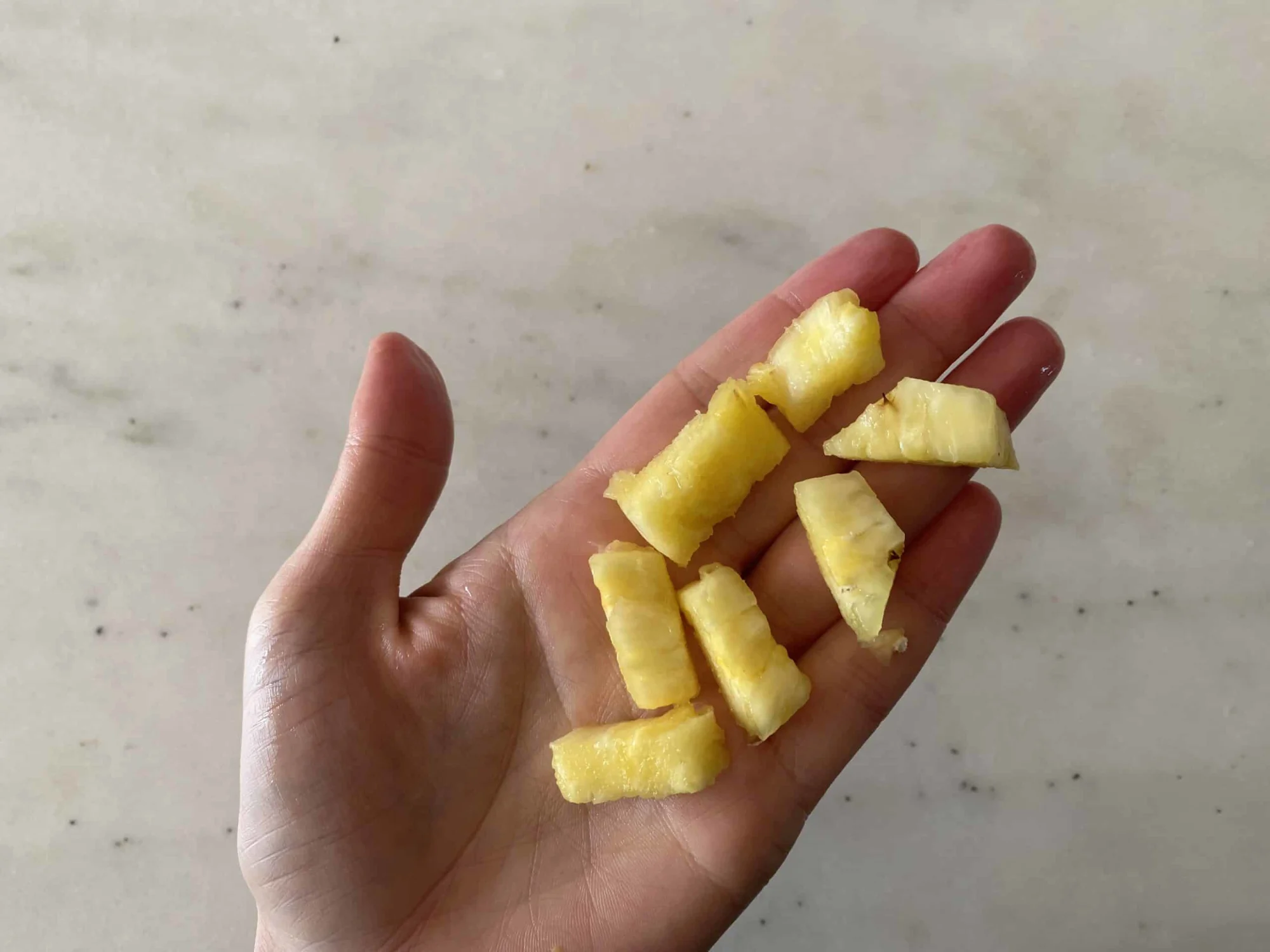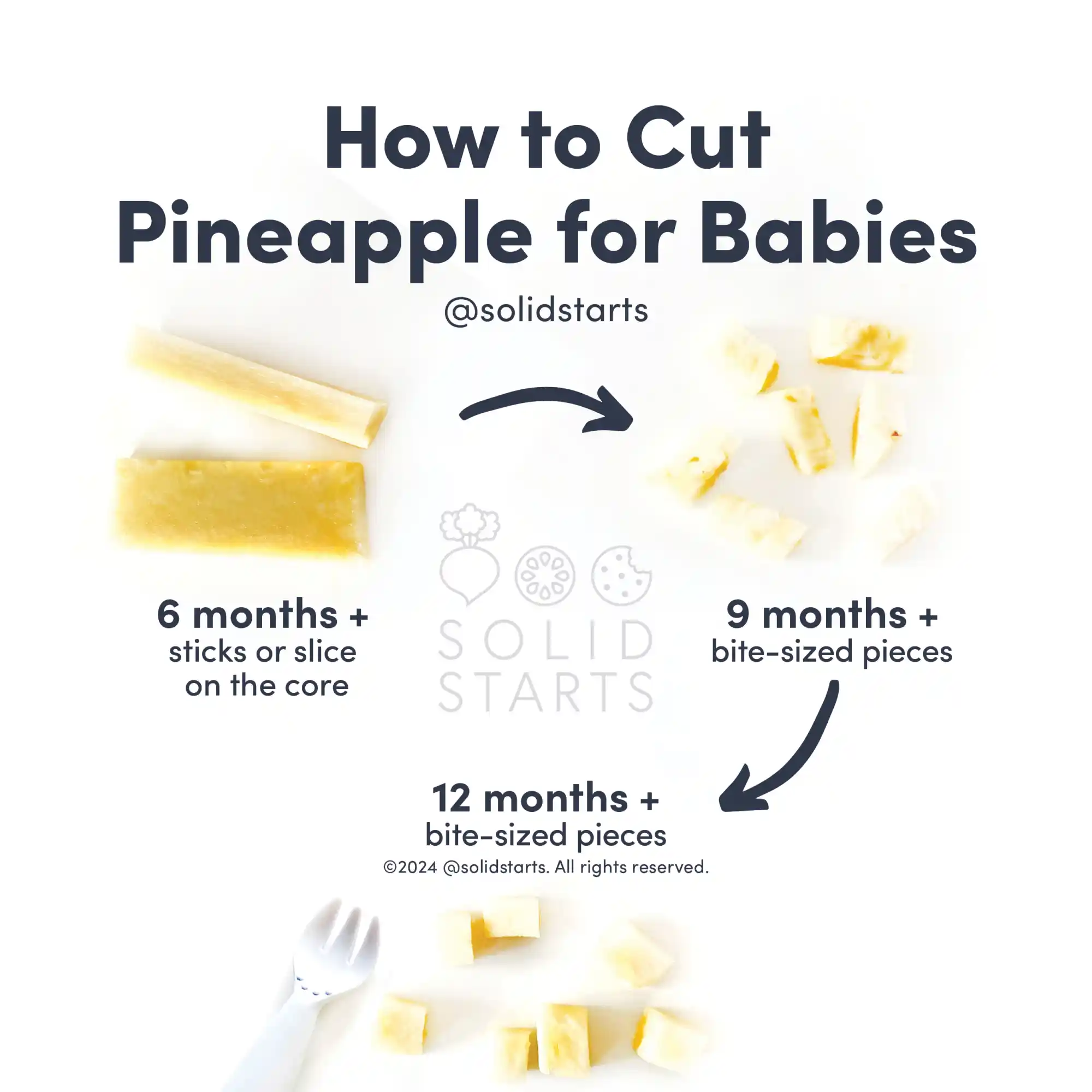Pineapple
Fruit
Age Suggestion
6 months
Iron-Rich
No
Common Allergen
No

When can babies have pineapple?
Pineapple may be introduced as soon as baby is ready to start solids, generally around 6 months of age. Pineapple and other acidic foods may cause a harmless, temporary rash on skin that comes into contact with the juices and can contribute to diaper rash.
Pineapple has been cultivated for thousands of years in the land of its origin, the tropical lowlands of South America, including the area now known as Brazil. There, the Tupi people created diverse ways to turn the fruit they called na’na (among other names) into nourishing meals and fermented drinks. Colonization of Brazil and other parts of the American tropics introduced pineapple to Europe and beyond, although the fruit remained a luxury item in many temperate climates for hundreds of years.
Is pineapple healthy for babies?
Yes. Pineapple is a good source of carbohydrates, vitamins B6 and C, folate, and fiber, as well as trace amounts of a variety of other vitamins and minerals. Together, these nutrients help support baby’s energy, metabolism, iron absorption, neurodevelopment, digestive health, and immune function. Pineapple also contains antioxidants and carotenoids, such as epicatechin. When serving pineapple, make sure that it is ripe, as unripe pineapple can be irritating to the digestive system.
Pineapple contains bromelain, a protein-digesting enzyme that can cause irritation in the mouth after eating lots of the fruit. While this may be uncomfortable, there is no cause for concern. Cooking pineapple helps prevent this sensation, and serving the fruit with a neutralizing food like coconut milk or yogurt can help lessen the feeling.
Is pineapple a common allergen?
No. Allergies to pineapple are uncommon, but they have been reported and may be more likely in individuals with latex allergies. While most allergic reactions to pineapple are not severe, serious allergic reactions to bromelain, the major allergenic protein in pineapple, have also been reported. Individuals with Oral Allergy Syndrome who are allergic to pollen and/or latex may be sensitive to pineapple. Oral Allergy Syndrome typically results in short-lived itching, tingling, or burning in the mouth and is unlikely to result in a dangerous reaction. Pineapple that is cooked or canned can help minimize the reaction. There have also been reports that treating pineapple with salt or consuming along with dairy products might minimize reactions.
The enzymes in pineapple, such as bromelain, can temporarily irritate the mouth and tongue, causing a tingling or burning sensation that can be difficult to distinguish from Oral Allergy Syndrome. Cooking pineapple can help reduce this irritation.
Sometimes the natural acidity of pineapple can cause a harmless rash upon contact with the skin, typically around the mouth, but also occasionally in the diaper area. The rash usually dissipates quickly without treatment. To prevent irritation, apply a barrier ointment, such as petroleum jelly or a plant-based oil-wax combination, to baby’s face and diaper area before a meal with pineapple.
If you suspect baby may be allergic to pineapple, consult an allergist. As you would when introducing any new food, start by offering a small quantity for the first few servings. If there is no adverse reaction, gradually increase the quantity over future meals.
Is pineapple a choking hazard for babies?
Yes. Pineapple can be firm and slippery, which are two qualities that can increase the risk of choking. To reduce the risk, prepare and serve pineapple in an age-appropriate way as described in the How to Serve section. Note that pineapple has a mixed consistency—in other words, there are both solids and juice in a bite of pineapple, which move differently in baby’s mouth. This consistency may cause coughing as baby practices eating the food. As always, make sure you create a safe eating environment and stay within an arm’s reach of baby during meals.
Learn the signs of choking and gagging and more about choking first aid in our free guides, Infant Rescue and Toddler Rescue.
Videos
When can babies drink pineapple juice?
Small amounts of pineapple juice may be shared as a drink after 12 months of age. That said, it can be beneficial to wait for when a child is older to regularly share juice and other sugary drinks. Research suggests that regular intake of juice and other sweet drinks tends to increase the risk of dental cavities and take up space in the belly, which may decrease a child’s motivation to eat other foods at mealtime and may negatively affect the child’s growth. However, occasional servings of juice after one year of age generally isn’t a cause for concern. Learn more about serving juice to babies and toddlers.
How do you serve pineapple to babies?
Every baby develops on their own timeline, and the suggestions on how to cut or prepare particular foods are generalizations for a broad audience.
6 months old +:
Offer the core of a ripe pineapple as a food teether, or long, flat strips of soft, ripe pineapple. While the core won’t result in food in the belly, it can help advance oral motor skills by stimulating reflexes that baby uses to learn how to chew. If baby can bite through the core, stop serving the core to reduce choking risk and offer soft, ripe pineapple that has been peeled and cut into long, flat strips about the size of two adult fingers pressed together. When offering the strips, it is important to make sure that the fruit is ripe enough: hold a strip between your thumb and finger and gently press. If it gives under light pressure, it is safe to share with baby at this age. Serving pineapple alongside a creamy food like coconut milk or yogurt can help neutralize the natural acidity in the fruit and offset any harmless burning sensation that the child may feel on the tongue.
At this age, do not offer pre-cut cubes or canned pineapple chunks, as these shapes pose a high risk of choking. Instead, finely chop the cubes or chunks to minimize the risk. Alternatively, offer whole rings of canned pineapple. Some canned pineapple may be soft enough that it falls apart in baby’s hands; if baby is interested in trying to pick up and eat the pieces, it’s fine to let them do so.
9 months old +:
Serve bite-sized pieces of soft, ripe pineapple, either on their own as practice for baby’s developing pincer grasp or as part of a meal. Make sure that the pineapple passes the squish test: hold a piece between your thumb and finger and gently press. If it gives under light pressure, it is safe to share with baby. If you’d like to continue serving the whole pineapple core or large, flat strips of pineapple, you may. Just stop offering the core if baby can bite through it entirely.
12 months old +:
Continue to offer bite-sized pieces of pineapple and consider serving the fruit alongside a utensil for practice. Just remember that using utensils can be exhausting for new eaters, and many children toggle back and forth between feeding themselves with their fingers and utensils. Consistent and accurate utensil use will come in due time, with most children able to use a fork accurately by 3 years of age.


Preparing pineapple for babies 6 months +
Break out of the lunch rut with our guide, 75 Lunches for Babies & Toddlers.
Written by
Expert Tips Delivered to Your Inbox
Sign up for weekly tips, recipes and more!
The content offered on SolidStarts.com is for informational purposes only. Solidstarts is not engaged in rendering professional advice, whether medical or otherwise, to individual users or their children or families. No content on this site, regardless of date, should ever be used as a substitute for direct medical advice from your doctor or your medical or health professional, nutritionist, or expert in pediatric feeding and eating. By accessing the content on SolidStarts.com, you acknowledge and agree that you are accepting the responsibility for your child’s health and well-being. In return for providing you with an array of content “baby-led weaning” information, you waive any claims that you or your child may have as a result of utilizing the content on SolidStarts.com.








